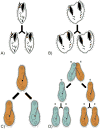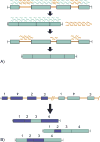Insights into transgenerational epigenetics from studies of ciliates
- PMID: 28689743
- PMCID: PMC5827946
- DOI: 10.1016/j.ejop.2017.05.004
Insights into transgenerational epigenetics from studies of ciliates
Abstract
Epigenetics, a term with many meanings, can be broadly defined as the study of dynamic states of the genome. Ciliates, a clade of unicellular eukaryotes, can teach us about the intersection of epigenetics and evolution due to the advantages of working with cultivable ciliate lineages, plus their tendency to express extreme phenotypes such as heritable doublet morphology. Moreover, ciliates provide a powerful model for studying epigenetics given the presence of dimorphic nuclei - a somatic macronucleus and germline micronucleus - within each cell. Here, we exemplify the power of studying ciliates to learn about epigenetic phenomena. We highlight "classical" examples from morphology and physiology including cortical inheritance, mating type determination, and serotype expression. In addition, we detail molecular studies of epigenetic phenomena, including: DNA elimination; alternative processing and unscrambling; and copy number determination. Based on the implications of these studies, we discuss epigenetics as a possible functional mechanism for rapid speciation in ciliates.
Keywords: Ciliates; Cortical inheritance; DNA processing; Mating type determination; Serotype inheritance; Transgenerational epigenetics.
Copyright © 2017 The Authors. Published by Elsevier GmbH.. All rights reserved.
Figures



Similar articles
-
A comparative study of genome organization and epigenetic mechanisms in model ciliates, with an emphasis on Tetrahymena, Paramecium and Oxytricha.Eur J Protistol. 2017 Oct;61(Pt B):376-387. doi: 10.1016/j.ejop.2017.06.006. Epub 2017 Jul 1. Eur J Protistol. 2017. PMID: 28735853 Review.
-
Analyses of alternatively processed genes in ciliates provide insights into the origins of scrambled genomes and may provide a mechanism for speciation.mBio. 2015 Feb 3;6(1):e01998-14. doi: 10.1128/mBio.01998-14. mBio. 2015. PMID: 25650397 Free PMC article.
-
Non-Mendelian inheritance of paralogs of 2 cytoskeletal genes in the ciliate Chilodonella uncinata.Mol Biol Evol. 2007 Nov;24(11):2495-503. doi: 10.1093/molbev/msm203. Epub 2007 Sep 22. Mol Biol Evol. 2007. PMID: 17890762
-
Micronuclear and macronuclear forms of beta-tubulin genes in the ciliate Chilodonella uncinata reveal insights into genome processing and protein evolution.J Eukaryot Microbiol. 2007 May-Jun;54(3):275-82. doi: 10.1111/j.1550-7408.2007.00267.x. J Eukaryot Microbiol. 2007. PMID: 17552983
-
Paramecium epigenetics in development and proliferation.J Eukaryot Microbiol. 2022 Sep;69(5):e12914. doi: 10.1111/jeu.12914. Epub 2022 May 4. J Eukaryot Microbiol. 2022. PMID: 35363910 Review.
Cited by
-
Epigenetic influences of mobile genetic elements on ciliate genome architecture and evolution.J Eukaryot Microbiol. 2022 Sep;69(5):e12891. doi: 10.1111/jeu.12891. Epub 2022 Feb 19. J Eukaryot Microbiol. 2022. PMID: 35100457 Free PMC article. Review.
-
Macronuclear development in ciliates, with a focus on nuclear architecture.J Eukaryot Microbiol. 2022 Sep;69(5):e12898. doi: 10.1111/jeu.12898. Epub 2022 Mar 16. J Eukaryot Microbiol. 2022. PMID: 35178799 Free PMC article. Review.
-
Temperature affects the repeatability of evolution in the microbial eukaryote Tetrahymena thermophila.Ecol Evol. 2021 Aug 23;11(19):13139-13152. doi: 10.1002/ece3.8036. eCollection 2021 Oct. Ecol Evol. 2021. PMID: 34646458 Free PMC article.
-
Future medicine: from molecular pathways to the collective intelligence of the body.Trends Mol Med. 2023 Sep;29(9):687-710. doi: 10.1016/j.molmed.2023.06.007. Epub 2023 Jul 20. Trends Mol Med. 2023. PMID: 37481382 Free PMC article. Review.
-
Genome plasticity in response to stress in Tetrahymena thermophila: selective and reversible chromosome amplification and paralogous expansion of metallothionein genes.Environ Microbiol. 2018 Jul;20(7):2410-2421. doi: 10.1111/1462-2920.14251. Epub 2018 May 22. Environ Microbiol. 2018. PMID: 29687579 Free PMC article.
References
-
- Ammermann D. Giant chromosomes in ciliates. Results Probs Cell Differ. 1987;14:59–67. - PubMed
-
- Arnaiz O, Mathy N, Baudry C, Malinsky S, Aury JM, Wilkes CD, Garnier O, Labadie K, Lauderdale BE, Le Mouel A, Marmignon A, Nowacki M, Poulain J, Prajer M, Wincker P, Meyer E, Duharcourt S, Duret L, Betermier M, Sperling L. The Paramecium germline genome provides a niche for intragenic parasitic DNA: evolutionary dynamics of internal eliminated sequences. Plos Genetics. 2012;8:e1002984. - PMC - PubMed
-
- Beale GH. The Antigen System of Paramecium-Aurelia. Int Rev Cytol. 1957;6:1–23.
Publication types
MeSH terms
Grants and funding
LinkOut - more resources
Full Text Sources
Other Literature Sources

